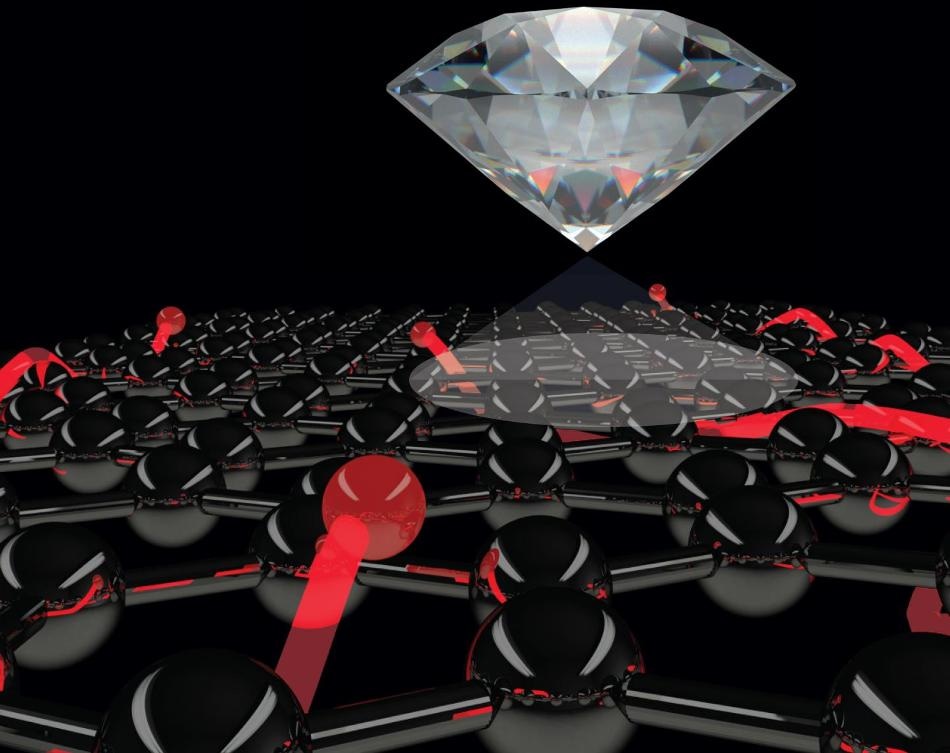Apr 27 2017
 Artist's impression of a diamond quantum sensor. The 'spotlight' represents light passing through the diamond defect and detecting the movement of electrons. Electrons are shown as red spheres, trailed by red threads that reveal their path through graphene (a single layer of carbon atoms). Credit: David A. Broadway/cqc2t.org
Artist's impression of a diamond quantum sensor. The 'spotlight' represents light passing through the diamond defect and detecting the movement of electrons. Electrons are shown as red spheres, trailed by red threads that reveal their path through graphene (a single layer of carbon atoms). Credit: David A. Broadway/cqc2t.org
As a boost to the development of next-generation electronics, a team of researchers at the University of Melbourne have proved to be the first in the world to image how electrons move in two-dimensional graphene.
The new technique has the potential to image the behavior of moving electrons in structures only one atom in thickness and thus overcomes major limitations with the currently available methods in order to understand electric currents in devices based on ultra-thin materials.
Next-generation electronic devices based on ultra-thin materials, including quantum computers, will be especially vulnerable to contain minute cracks and defects that disrupt current flow.
Professor Lloyd Hollenberg, Deputy Director of the Centre for Quantum Computation and Communication Technology
A team headed by Hollenberg used a special quantum probe based on an atomic-sized 'color center' present only in diamonds to image the flow of electric currents in graphene. It is possible to use this technique to understand electron behavior in a wide range of new technologies.
The ability to see how electric currents are affected by these imperfections will allow researchers to improve the reliability and performance of existing and emerging technologies. We are very excited by this result, which enables us to reveal the microscopic behavior of current in quantum computing devices, graphene and other 2D materials. Researchers at CQC2T have made great progress in atomic-scale fabrication of nanoelectronics in silicon for quantum computers. Like graphene sheets, these nanoelectronic structures are essentially one atom thick. The success of our new sensing technique means we have the potential to observe how electrons move in such structures and aid our future understanding of how quantum computers will operate.
Professor Lloyd Hollenberg, Deputy Director of the Centre for Quantum Computation and Communication Technology
The technique helps in understanding nanoelectronics that control quantum computers and can also be used with 2D materials in order to develop next generation electronics, bio-chemical sensors, flexible displays and energy storage (batteries).
"Our technique is powerful yet relatively simple to implement, which means it could be adopted by researchers and engineers from a wide range of disciplines," said lead author Dr Jean-Philippe Tetienne from CQC2T at the University of Melbourne.
"Using the magnetic field of moving electrons is an old idea in physics, but this is a novel implementation at the microscale with 21st Century applications."
The work was a group effort between diamond-based quantum sensing and graphene researchers. Their complementary expertise played a significant role in overcoming technical issues with combining graphene and diamond.
"No one has been able to see what is happening with electric currents in graphene before," said Nikolai Dontschuk, a graphene researcher at the University of Melbourne School of Physics.
"Building a device that combined graphene with the extremely sensitive nitrogen vacancy color centre in diamond was challenging, but an important advantage of our approach is that it's non-invasive and robust - we don't disrupt the current by sensing it in this way," he said.
Tetienne explained how the researchers were able to use diamond to successfully image the current.
Our method is to shine a green laser on the diamond, and see red light arising from the color centre's response to an electron's magnetic field. By analysing the intensity of the red light, we determine the magnetic field created by the electric current and are able to image it, and literally see the effect of material imperfections.
Dr Jean-Philippe Tetienne, CQC2T, University of Melbourne
World-first images of electric currents in graphene
Animated artist's impression of the experimental setup for a quantum sensing experiment. The diamond quantum sensor is controlled by lasers. An atomistic representation of graphene (a single layer of carbon atoms) sits atop the sensor. Red lines represent the trajectory of the electrons as they move through the graphene. Credit: David A. Broadway/cqc2t.org